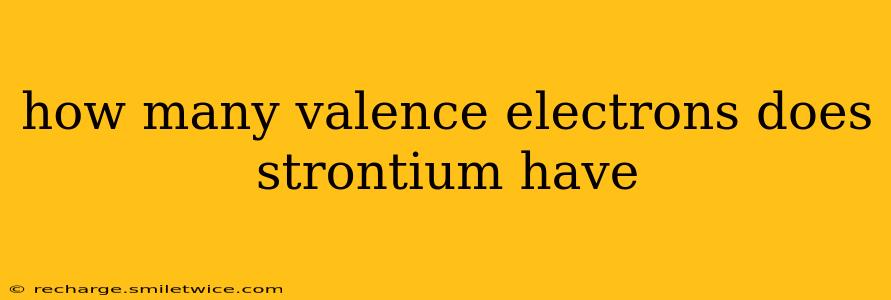How Many Valence Electrons Does Strontium Have?
Strontium, a silvery-white alkaline earth metal, boasts two valence electrons. Understanding valence electrons is crucial for comprehending an element's chemical behavior and reactivity. Let's delve deeper into why strontium has two, and what that means.
What are Valence Electrons?
Before we pinpoint strontium's valence electron count, let's define the term. Valence electrons are the electrons located in the outermost shell (or energy level) of an atom. These are the electrons most involved in chemical bonding, determining how an element interacts with other elements to form compounds. The number of valence electrons dictates an element's chemical properties and reactivity.
Strontium's Electron Configuration and Valence Electrons
Strontium's atomic number is 38, meaning it has 38 protons and 38 electrons in a neutral atom. Its electron configuration is [Kr]5s². This configuration tells us the arrangement of electrons across different energy levels. The [Kr] represents the electron configuration of krypton, a noble gas, indicating a filled inner shell. The crucial part is the 5s². This denotes two electrons in the 5s orbital, which is the outermost shell. Therefore, strontium possesses two valence electrons.
Why are Strontium's Two Valence Electrons Important?
The presence of two valence electrons explains strontium's characteristic properties:
-
Reactivity: Strontium readily loses its two valence electrons to achieve a stable electron configuration similar to krypton. This makes it highly reactive, particularly with nonmetals like oxygen and halogens. This reactivity is typical of alkaline earth metals.
-
Bonding: Strontium predominantly forms ionic bonds by losing its two valence electrons to become a +2 ion (Sr²⁺). These ions then interact electrostatically with negatively charged ions to form stable ionic compounds.
-
Chemical Behavior: Strontium's chemical behavior is largely determined by its tendency to lose these two electrons, making it a strong reducing agent.
What are some common Strontium Compounds?
Due to its two valence electrons and subsequent tendency to form a +2 ion, strontium forms various compounds, including:
- Strontium oxide (SrO): Formed by the reaction of strontium with oxygen.
- Strontium chloride (SrCl₂): Created through the reaction of strontium with chlorine.
- Strontium sulfate (SrSO₄): A relatively insoluble compound.
How does the number of valence electrons relate to the periodic table group?
Strontium belongs to Group 2 of the periodic table, also known as the alkaline earth metals. All elements in this group share a common characteristic: they have two valence electrons. This similarity in electronic structure accounts for the similar chemical properties observed within this group.
This detailed explanation clarifies why strontium possesses two valence electrons and how this characteristic influences its chemical properties and behavior. Understanding valence electrons provides a fundamental understanding of chemical bonding and reactivity.
